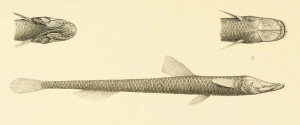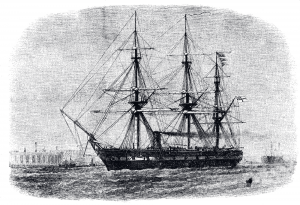FRIDAY, 25 JANUARY 2013
In the mid-nineteenth century, the deep ocean was a great blue blank on the surface of the globe. Naval expeditions such as the voyage of HMS Beagle in 1831-6 had brought back important observations of the oceans, but were concerned mainly with the surface waters, being as much military exercises as scientific ones. Azoic Theory, the idea that there was no life in the ocean deeper than 300 fathoms (about 550 metres) had also taken hold, leading many to assume that the deep ocean was a submarine wasteland not worth exploring .The expedition which finally blew open the deep oceans for research was that of HMS Challenger, planned by the influential scientists Charles Wyville Thompson and William Carpenter and led by George Strong Nares, who was later to become a distinguished Arctic explorer. Built in Woolwich in 1858, in the year that Darwin presented his theory of evolution, Challenger was to become the first oceanographic ship that ever sailed. Originally a warship, Challenger was painstakingly converted into a research vessel, most of her cannon removed to make space for laboratories and storerooms for specimens and scientific equipment. She set sail from Portsmouth in 1872, and travelled almost 69,000 miles around the world over the next four years, amassing thousands of samples of rocks, sediment and deep sea organisms. These would be the starting point for study of this greatest and most neglected of Earth’s landscapes.
Challenger’s first discoveries came almost immediately. The first sediment samples dredged up were, as expected, pale grey Globigerina ooze. Composed almost entirely of the calcite shells of foraminifera, a group of complex unicellular organisms, this ooze is now known to be an important carbon store in the oceans. As the ship moved south, however, they discovered something entirely new – a red clay composed of radiolarians, which have silica skeletons. This apparently esoteric discovery has major implications for the way the oceans respond to changes in chemistry and climate. John Murray, one of the ship’s naturalists, had shown that Globigerinae are ubiquitous in surface waters all over the world’s oceans, and there should be a constant rain of their shells into the deep oceans. Yet over vast areas, their shells are absent from the sediment on the sea floor. So where have all these shells gone?
This observation was the first evidence of the now well-recognised Carbonate Compensation Depth, the level at which calcium carbonate shells sinking into the deep ocean are dissolved at the same rate as they rain in. We now know that this depth has fluctuated with time, changing the amount of carbon which ocean sediments store, and the pH of the oceans. Ocean acidification and the storage of CO2 in ocean sediments have become important issues in modern oceanographic studies, and are important parameters in our models of how the oceans might respond to future environmental changes. Since the Challenger expedition, huge ocean drilling programs have recovered many cores of deep-sea sediment, and studies of oxygen isotopes in the calcite shells have shown us how ocean temperatures have changed over geological time – an excellent source of empirical information on the history of Earth’s climate.
Challenger’s findings also conclusively disproved the Azoic Theory, which had stifled research into deep-sea biology for so long. Dredging and sounding expeditions by Wyville Thompson on HMS Lightning and HMS Porcupine had already found some evidence that there was life in the oceans below 300 fathoms, the depth limit set by the Azoic Theory, but Challenger smashed those depth records, recovering annelid worm tubes from 3000 fathoms. These early hints at a deep-ocean ecosystem have blossomed in recent years into a host of new discoveries by deep sea rovers such as the Alvin submersible. The extent of deep-water ecosystems and their need for protection as the environment above them changes are still poorly understood, and dives regularly turn up entirely new species even today. The discovery of life around hydrothermal vents in the ocean floor in the 1970s revolutionised our ideas of what life needed to survive. Guided by our sunny, surface ecosystems, which rely on energy from photosynthesis, scientists were confronted with ecosystems which are independent of sunlight, relying on chemical energy instead. Consequently, we have become far more open to the possibility of life on other planets, or in areas previously considered sterile.
Another of Challenger’s objectives was to measure the depth of the ocean as it journeyed around the world. Its results revealed some tantalising clues about the underlying landscape of the ocean floor. While crossing the Atlantic, the scientists on board began to notice a pattern in the water temperatures they were recording, with a ‘cold stream’ to the west and a ‘warm stream’ to the east, part of the North Atlantic ocean circulation which includes the Gulf Stream. George Nares, puzzled by how water bodies of two different temperatures were kept separate over such great distances, speculated that they could be being kept apart by a great line of shoals stretching from north to south across the Atlantic. This was the first inkling we had of the existence of the mid-Atlantic Ridge, where the North American and Eurasian plates move slowly apart as new oceanic crust forms between them.
In 1973, almost one hundred years after Challenger crossed the ridge, the French deep-sea submersible Archimède made the first descent to the ridge and discovered the narrow zone where new crust forms. The theory of plate tectonics was only newly accepted, still finding its feet. Studies of the deep ocean features first surveyed by Challenger helped to establish its place in the realms of scientific fact.
On their return to England in May 1876, the Challenger researchers and crew were a depleted and exhausted party. Under the stress of cramped and unpleasant conditions on board, and strenuous work which few understood, around a quarter of her original crew of 269 had deserted or died. Challenger was eventually broken up in 1921, but by this time the legacy of the expedition was established. The huge quantity of sediment samples, bottled specimens and oceanographic data collected on the expedition took over 20 years to analyse, and the resulting report ran to 50 volumes. The deepest point in the ocean, at about 10.9km below the surface at the southern end of the Mariana Trench, is named the Challenger Deep after the expedition. It remains a great frontier in ocean research to this day, in the spirit of its oceangoing namesake.
Amelia Penny is a 4th year undergraduate in the Earth Sciences Department



